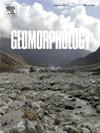A morphometric analysis of embayed beaches: southern Sardinia Island
IF 3.1
2区 地球科学
Q2 GEOGRAPHY, PHYSICAL
引用次数: 0
Abstract
Embayed beaches are widely distributed along the world's coastlines. They are characterised by a curvilinear shoreline and the presence of headlands (natural or artificial) that laterally constrain the beach. Several methods have been proposed in the scientific literature to estimate the degree of embaymentisation. This study carried out a morphometric analysis of embayed beaches along the southern coast of Sardinia Island and a classification comparison using the Platform Index (I) and the Embayment Morphometric Parameter (γe). Overall, 79 beaches were identified through the analysis of aerial orthophotos. Furthermore, the type of embayment (natural or artificial) and the degree of headland impact on the surf zone circulation, with the Non-Dimensional Embayment Scaling Parameter (δ′), were estimated. The results reveal that a detailed morphometric analysis of embayed beaches provides valuable insights into the beach dynamics that influence its morphology and response to hydrodynamic forcing. Given the increasing vulnerability of coastal zones to climate change, sea-level rise, and extreme weather events, such morphometric analyses play a crucial role in assessing the response of embayed beaches to these factors. Consequently, they provide a scientific basis for improving coastal management strategies, risk assessment, and resilience planning, particularly in beaches where data availability is limited or that has been alternated by human interventions, such as the construction of engineering structures.
撒丁岛南部海湾海滩的形态计量学分析
世界各地的海岸线上广泛分布着海湾海滩。它们的特点是曲线海岸线和海岬(自然或人工)的存在,这些海岬在侧面限制了海滩。科学文献中提出了几种方法来估计记忆力的程度。本研究对撒丁岛南部海岸的海湾海滩进行了形态计量分析,并使用平台指数(I)和海湾形态计量参数(γe)进行了分类比较。总体而言,通过航空正射影像分析确定了79个海滩。此外,利用无量纲河口标度参数(δ′)估算了河口类型(自然或人工)和河口对浪带环流的影响程度。结果表明,对海湾海滩进行详细的形态计量学分析,为了解影响其形态和对水动力强迫的响应的海滩动力学提供了有价值的见解。鉴于沿海地区对气候变化、海平面上升和极端天气事件的脆弱性日益增加,这种形态计量学分析在评估受污染海滩对这些因素的反应方面发挥着至关重要的作用。因此,它们为改进海岸管理策略、风险评估和恢复力规划提供了科学基础,特别是在数据可用性有限或被人为干预(如工程结构的建设)所替代的海滩。
本文章由计算机程序翻译,如有差异,请以英文原文为准。
求助全文
约1分钟内获得全文
求助全文
来源期刊

Geomorphology
地学-地球科学综合
CiteScore
8.00
自引率
10.30%
发文量
309
审稿时长
3.4 months
期刊介绍:
Our journal''s scope includes geomorphic themes of: tectonics and regional structure; glacial processes and landforms; fluvial sequences, Quaternary environmental change and dating; fluvial processes and landforms; mass movement, slopes and periglacial processes; hillslopes and soil erosion; weathering, karst and soils; aeolian processes and landforms, coastal dunes and arid environments; coastal and marine processes, estuaries and lakes; modelling, theoretical and quantitative geomorphology; DEM, GIS and remote sensing methods and applications; hazards, applied and planetary geomorphology; and volcanics.
 求助内容:
求助内容: 应助结果提醒方式:
应助结果提醒方式:


